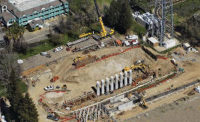
California utility regulators have proposed a $2.25-billion fine against PG&E for a 2010 natural-gas pipeline explosion in San Bruno, but the San Francisco-based utility claims the true cost to its shareholders would approach $4 billion, including money already spent on safety upgrades.
The 30-in.-dia pipeline rupture killed eight people, injured 58 and decimated a residential neighborhood in the Bay Area suburb.
Earlier this year, the California Public Utilities Commission (CPUC) proposed a total $2.25-billion penalty, which would all be spent on pipeline safety enhancements.
But in a brief last week, the commission's Consumer Protection and Safety Division recommended that, of that total, a minimum of $300 million should be levied as a fine, paid into the state's general fund, "in light of PG&E's extensive violations of its safety obligations under California law and regulations."
The division's brief goes on to say the explosion was "directly caused by PG&E's unreasonable conduct and neglect for decades."
The explosion occurred when faulty seam welds in a section of pipe that was supposed to be seamless ruptured under the high-pressure gas. In a previous report, the National Transportation Safety Board faulted PG&E for lax oversight, inadequate pipe and inspection programs and poor record-keeping.
PG&E asserts the new penalty would impede pipeline improvements.
"We wouldn't be able to use that $300 million to pay for significant safety-enhancement upgrades such as hydrotesting, pipeline replacement or valve automation," says PG&E spokesman Daren Chan. "We feel that is a real disadvantage to our customers and to building a safer system. That's a real sticking point for us."
To date, PG&E has spent $800 million on its pipeline safety-enhancement plan, including strength-testing 485 miles of pipe, replacing 59 miles of pipe, automating 78 valves and, to allow for in-line inspection tools, retrofitting 78 miles of pipe. The work has been concentrated on immediate pipeline safety upgrades in heavily populated areas.
In addition, the utility says it has spent nearly $1 billion for additional gas safety work.
In its interpretation of the new division recommendations, PG&E contends that, so far, none of the nearly $1.8 billion spent would count toward the $2.25-billion penalty and that the burden to pay for the fine must rest on shareholders, rather than ratepayers.
This brings the true shareholder cost to $4 billion, Chan says.
Standard & Poor's Ratings Direct (which, like ENR, is owned by McGraw Hill Financial) notes that the penalty would force S&P to reevaluate the regulatory risk of doing business in California.
If the division's proposal is adopted, S&P would review its assessment of the California regulatory jurisdiction, says S&P analyst Gabe Grosberg, adding that "a downward revision to this assessment could affect ratings on all electric, gas and water companies that the CPUC regulates."




Post a comment to this article
Report Abusive Comment